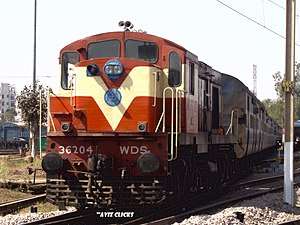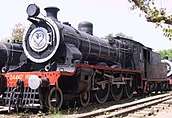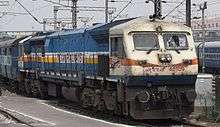Indian locomotive class WDS-6
The class WDS-6 is a diesel-electric locomotive used by Indian Railways for shunting and doing departmental works. The model name stands for broad gauge (W), Diesel (D), Shunting (S) engine. The WDS-6 is used all over India.
| Indian locomotive class WDS-6 | |||||||||||||||||||||||||||||||||||||||||||||||||||||||||||
|---|---|---|---|---|---|---|---|---|---|---|---|---|---|---|---|---|---|---|---|---|---|---|---|---|---|---|---|---|---|---|---|---|---|---|---|---|---|---|---|---|---|---|---|---|---|---|---|---|---|---|---|---|---|---|---|---|---|---|---|
 Raipur WDS-6 doing some shunting jobs at Durg Junction | |||||||||||||||||||||||||||||||||||||||||||||||||||||||||||
| |||||||||||||||||||||||||||||||||||||||||||||||||||||||||||
| |||||||||||||||||||||||||||||||||||||||||||||||||||||||||||
| |||||||||||||||||||||||||||||||||||||||||||||||||||||||||||
| |||||||||||||||||||||||||||||||||||||||||||||||||||||||||||
History
The class was created in 1975 to address the need for powerful shunting locomotive that will be able to haul 20-24 coach rakes. The previous WDS-4 class was underpowered for this kind of operation. The WDS-6 locos consist of the YDM-4 powerpack (6-cylinder 4-stroke inline Alco engine, turbo-supercharged) placed on WDM-2 frames. They were manufactured by DLW varanasi and later Parel Workshops started building them using the kits provided by DLW. The WDS-6 can easily be recognized by their shot nose and flat-ended cab at one end. They were sold and transferred to industrial concerns and public sectors in huge numbers, but have IR road numbers on them.
Locomotive sheds
| Zone | Name | Shed Code | Quantity |
|---|---|---|---|
| Central Railway | Pune | PA | 1 |
| Kurla | CLA | 50 | |
| Eastern Railway | Howrah | HWH | 18 |
| Beliaghata Sealdah | BGA | 27 | |
| Bardhaman | BWN | 2 | |
| Andal | UDL | 6 | |
| Jamalpur | JMP | 2 | |
| East Central Railway | Patratu | PTRU | 5 |
| Pt. DD Upadhyaya Junction | DDU | 13 | |
| East Coast Railway | Visakhapatnam | VSKP | 10 |
| Northern Railway | Tughlakabad | TKD | 11 |
| Shakurbasti | SSB | 21 | |
| Ludhiana | LDH | 3 | |
| Lucknow | LKO | 4 | |
| North Central Railway | Jhansi | JHS | 13 |
| North Eastern Railway | Gonda | GD | 4 |
| Izzatnagar | IZN | 1 | |
| Northeast Frontier Railway | Guwahati | NGC | 12 |
| Southern Railway | Erode | ED | 6 |
| Ernakulam | ERS | 1 | |
| Golden Rock | GOC | 1 | |
| Tondiarpet | TNP | 12 | |
| South Central Railway | Kazipet | KZJ | 1 |
| Guntakal | GTL | 3 | |
| Vijayawada | BZA | 5 | |
| South Eastern Railway | Kharagpur | KGP | 17 |
| Bondamunda | BNDM | 8 | |
| Bokaro Steel City | BKSC | 10 | |
| South East Central Railway | Raipur | R | 20 |
| South Western Railway | Krishnarajapuram | KJM | 3 |
| Western Railway | Ratlam | RTM | 5 |
| Vatva | VTA | 19 | |
| Gandhidham | GIMB | 4 | |
| Bandra Marshalling Yard | BAMY | 24 | |
| West Central Railway | Itarsi | ET | 17 |
| New Katni Junction | KTE | 3 | |
| Unknown | 13 | ||
| Total Locomotives in Service till July 2020[1] | 375 | ||
Technical specifications
| Manufacturers | DLW, Parel Workshop |
| Engine | Alco 251-D, Inline-6, 1,400 hp (1,000 kW) (1,300 hp or 970 kW site rating) with Alco turbocharged engine. 1,100 rpm max, 400 rpm idle; 228 mm × 267 mm (8.98 in × 10.51 in) bore x stroke; compression ratio 12.5:1. |
| Transmission | Electric, DC-DC (DC Generator and DC Traction motor) |
| Traction motors | GE for original Alco and MLW models, BHEL for DLW |
| Axle load | 21 t (21 long tons; 23 short tons) |
| total weight | 113 t (111 long tons; 125 short tons) |
| Bogies | Alco design cast frame trimount (Co-Co) bogies |
| Starting TE | 34 t (33 long tons; 37 short tons), at adhesion 27% |
| Length over buffer beams | 17,370 mm (56 ft 11 7⁄8 in) |
| Distance between bogies | 10,516 mm (34 ft 6 in) |
See also
- History of rail transport in India
- Locomotives of India
- Rail transport in India
- Indian locomotive class YDM-4
Bibliography
- Hughes, Hugh (1996). Indian Locomotives: Part 4 – 1941–1990. Harrow, Middlesex: The Continental Railway Circle. ISBN 0-9521655-1-1.
References
- RDSO document for WDS-6(archived copy)
- https://www.irfca.org/faq/faq-loco2d.html
- https://www.irfca.org/faq/faq-specs.html#WDS-6
- https://www.irfca.org/apps/locos/list
| Wikimedia Commons has media related to Indian locomotive class WDS6. |



